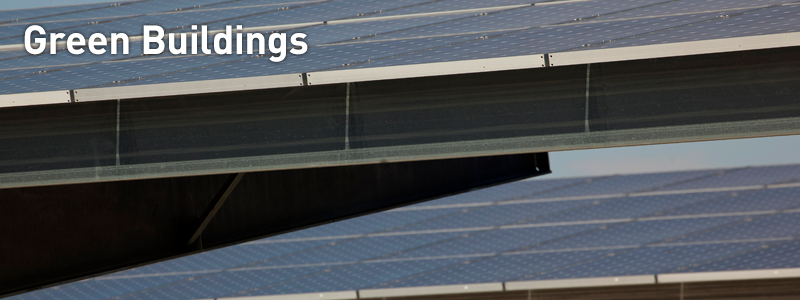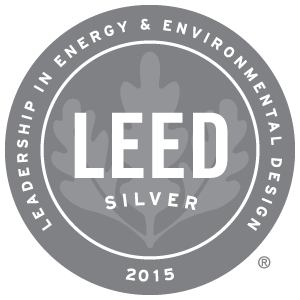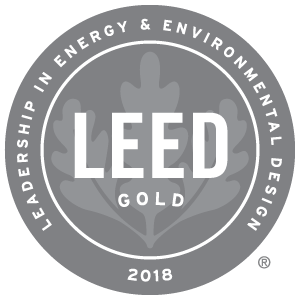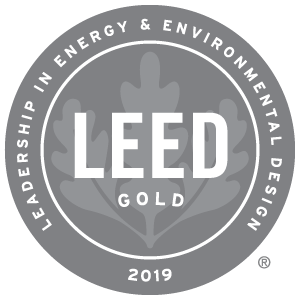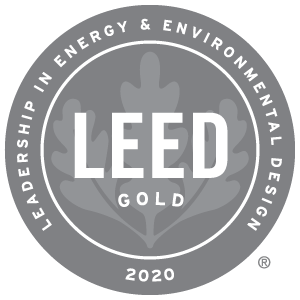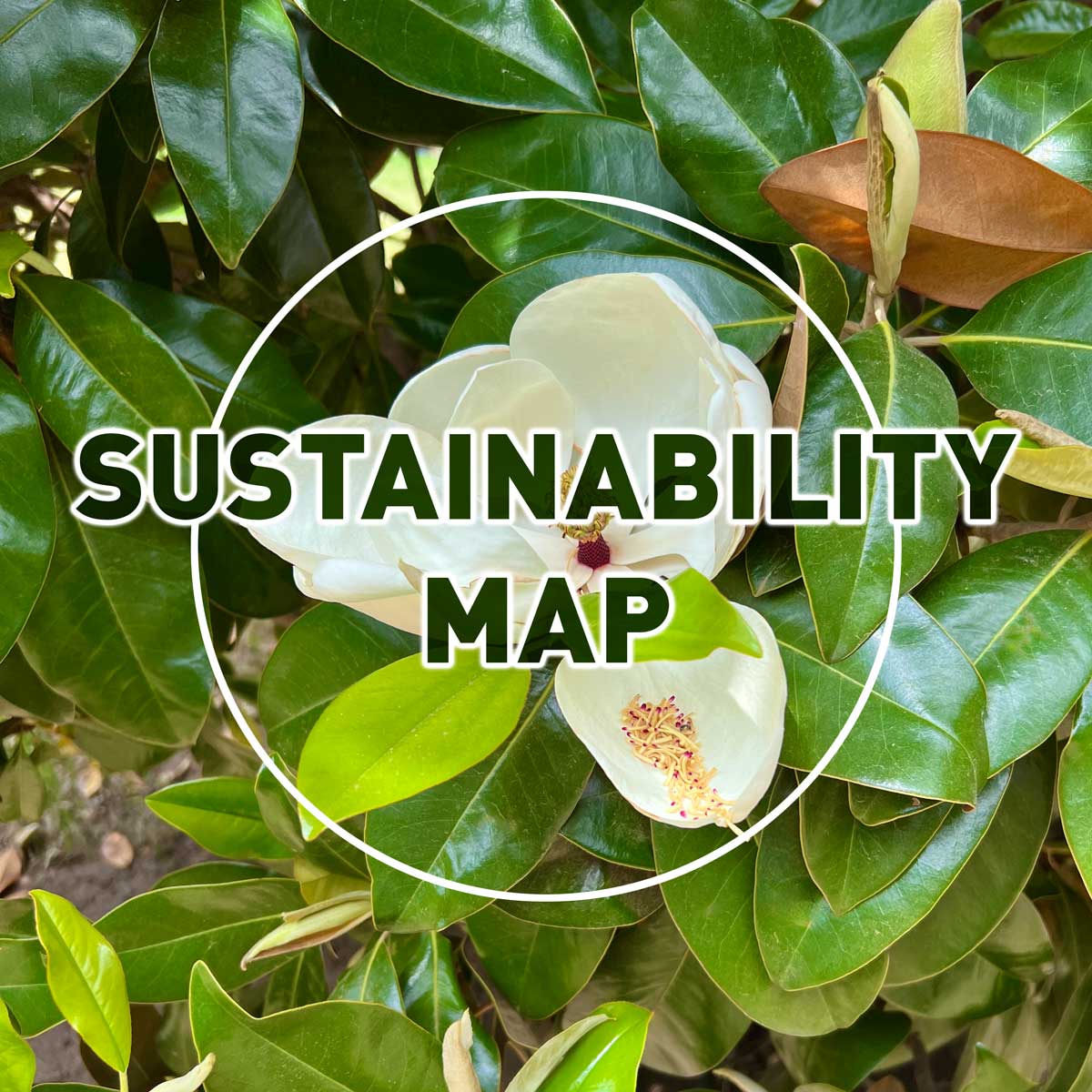UT Dallas has undergone tremendous growth over the past 10 years. To support the campus’ increasing enrollment and infrastructure, Facilities Management has taken steps to build more efficient buildings, pursuing LEED [Leadership in Energy and Environmental Design] Certification on a number of them.
To request a tour of any the green buildings on campus, please contact sustainability@utdallas.edu.
Student Services Building
USGBC® and the related logo are trademarks owned by the US Green Building Council and are used with permission. usgbc.org
- Certified LEED [Leadership in Energy and Environmental Design] Platinum
- Project Completed: July 2010
- Total Project Cost: $27,500,000
- Size: 74,343 gsf [gross square feet]
Project Goals and Accomplishments
The goal of the Student Services Building (SSB) project was to design a building that was at least 50% more energy efficient than the average of all buildings on campus.
- “Floating” terra-cotta louvers on the building’s exterior respond to the solar exposure in appropriate density.
- The building’s energy efficiency is designed to perform 41% over Ashrae 90.1, offering $60,000 annual electrical savings representing a 63% improvement over the average of all buildings on campus.
- The building maximizes Daylight Harvesting while providing 76% of all occupied spaces with natural daylight and 93% of all occupied spaces with views to the outside.
- The design incorporates water conservation measures such as automatic sensors in faucets, dual flush toilets and low-flow (1 pint) urinals.

Space planning was approached from the perspective of “doing more with less,” utilizing space efficiently, and creating opportunities to share space without duplicating space that would sit unoccupied most of the day.
- An innovative, functional and efficient new space planning protocol was achieved by reducing the number of individual offices in favor of open office planning with multi-use spaces, plus shared conference and meeting rooms accessible by all departments via public corridors.
- The benefits of open office space and shared meeting spaces versus individual offices achieved a 73% assignable to non-assignable building space ratio.
Sustainability Awards
- Judge’s Choice Award for Energy Efficiency and Conservation; College Planning & Management, November 2011
- Innovation in Green Building Award; AASHE [Association for the Advancement of Sustainability in Higher Education] , USGBC [United States Green Building Council] , October 2011
- Green School Award in the Higher Education category; US Green Building Council / Balcones chapter, October 2011)
- Green Project Award of Merit; ENR [Engineering News-Record] Texas & Louisiana, October 2011
- Public Green Deal of the Year; Dallas Business Journal, February 2011
Source: Building Reaps Multiple Sustainability Honors, UT Dallas News Center, December 13 2011
School of Management Addition
USGBC® and the related logo are trademarks owned by the US Green Building Council and are used with permission. usgbc.org
- Certified LEED [Leadership in Energy and Environmental Design] Silver
- Project Completed: August 2014
- Total Project Cost: $27,500,000
- Size: 107,445 gsf [gross square feet]
The Naveen Jindal School of Management (JSOM) addition is a certified green building due to water and energy conservation features within the building. Recycled content of building materials and enhanced building commissioning also contribute to the LEED [Leadership in Energy and Environmental Design] certification. An Innovation in Design credit was achieved for creative use of open space in the courtyard.
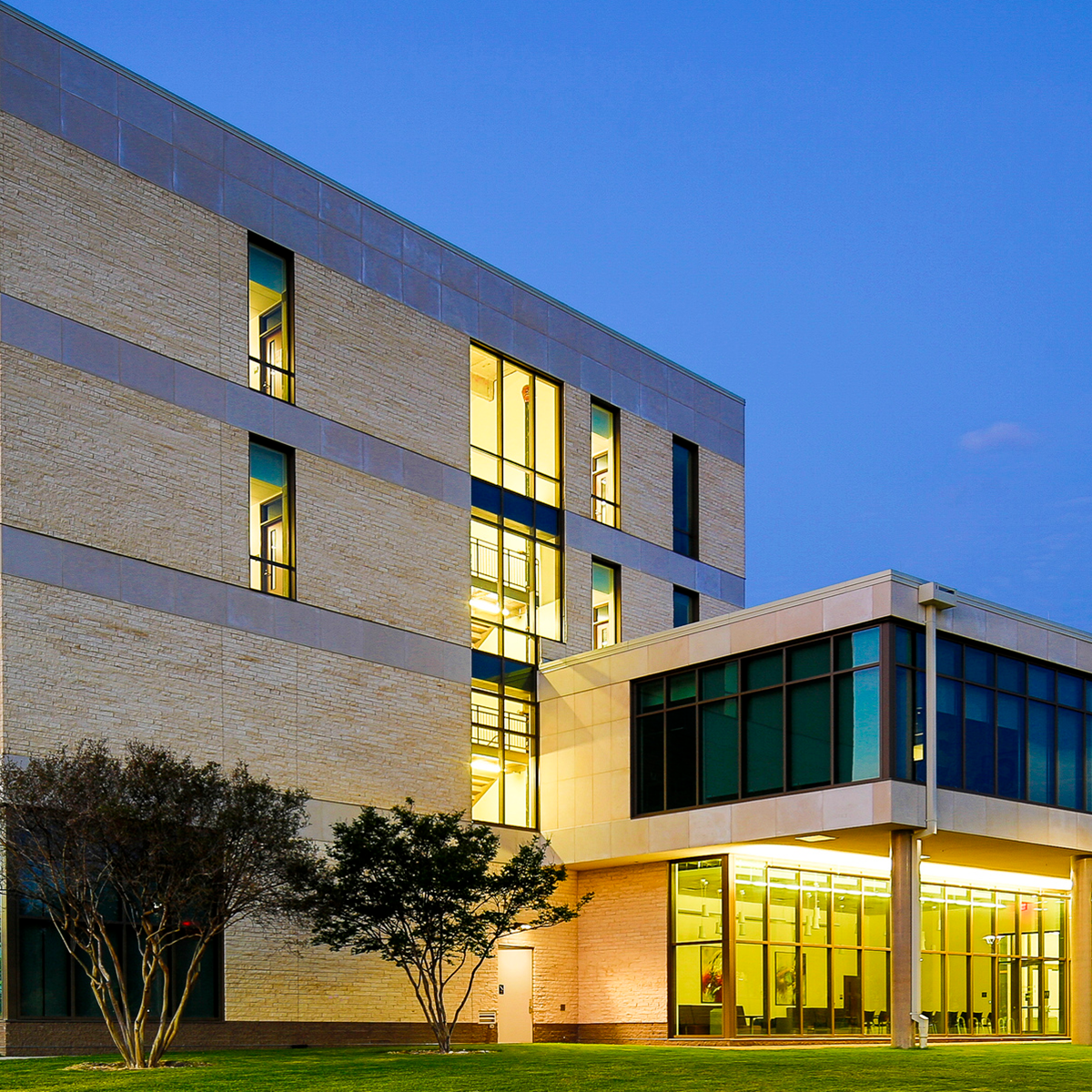
Parking Structure 1
- Zero-Net Energy
- Project Completed: August 2013
- Total Project Cost: $12,000,000
- Size: 251,500 gsf [gross square feet]
Parking Structure 1 (PS1) was built with a 220kw [kilowatts] solar photovoltaic array on the fifth floor. It provides shaded parking as well as enough energy to make PS1 a zero-net energy building. LED [Light Emitting Diode] lighting and daylight harvesting reduce the demand for energy throughout the structure.

Edith O’Donnell Arts & Technology Building
USGBC® and the related logo are trademarks owned by the US Green Building Council and are used with permission. usgbc.org
- Certified LEED [Leadership in Energy and Environmental Design] Silver
- Project Completed: August 2013
- Total Project Cost: $60,500,000
- Size: 157,920 gsf [gross square feet]
The Edith O'Donnell Arts and Technology Building (ATC) met LEED [Leadership in Energy and Environmental Design] goals through a number of innovative design features. The building repurposed land that had been a tennis court, parking lot, and a bookstore. The white roof provides an energy efficiency credit by minimizing our heat island effect. Energy and water conservation measures within the building ensure efficiency and savings throughout the life of the building.

Andromeda Hall / Dining Hall West / Rec Center West
USGBC® and the related logo are trademarks owned by the US Green Building Council and are used with permission. usgbc.org
- Certified LEED [Leadership in Energy and Environmental Design] Silver
- Project Completed: August 2014
- Total Project Cost: $66,600,000
- Size: 316,532 gsf [gross square feet]
The Andromeda Hall complex (RHA / DHW / RCW) was certified under LEED [Leadership in Energy and Environmental Design] as a group project, as opposed to 3 separate buildings. The buildings do use a common heating and cooling system, making them very efficient. Expansion of the pond adjacent to Dining Hall West contributed to storm water credits under the LEED [Leadership in Energy and Environmental Design] criteria. Energy and water conservation measures throughout the complex ensure efficiency and savings throughout the life of the building.

Bioengineering and Science Building
USGBC® and the related logo are trademarks owned by the US Green Building Council and are used with permission. usgbc.org
- Certified LEED [Leadership in Energy and Environmental Design] Gold
- Project Completed: December 2015
- Total Project Cost: $113,000,000
- Size: 222,651 gsf [gross square feet]
The Bioengineering Science Building (BSB) has sustainable wood products throughout and a lighting conservation system that adjust to the amount of light outside the building using daylight harvesting sensors. In addition, rainwater collected from the roof irrigates the grounds of BSB and the Natural Science and Engineering Research Laboratory (RL).

Davidson-Gundy Alumni Center
USGBC® and the related logo are trademarks owned by the US Green Building Council and are used with permission. usgbc.org
- Certified LEED [Leadership in Energy and Environmental Design] Gold
- Project Completed: August 2017
- Size: 30,246 gsf [gross square feet]
Harnessing natural greenscape features and the use of reflective surfaces, the Davidson-Gundy Alumni Center (DGA) is a stellar example of a green building with heat-island effect reduction in mind. With strategically designed window placement in conjunction with surrounding shade trees, heating and cooling within the building is more controllable. This building was designed to be energy efficient while at the same time, capitalizing on the use of natural sunlight. The event and conference space energy systems can respond quickly and efficiently to changes in occupancy. Contributing to the building’s LEED [Leadership in Energy and Environmental Design] credentials, the use of recycled and locally sourced materials during the construction phase was a key factor in earning Gold.
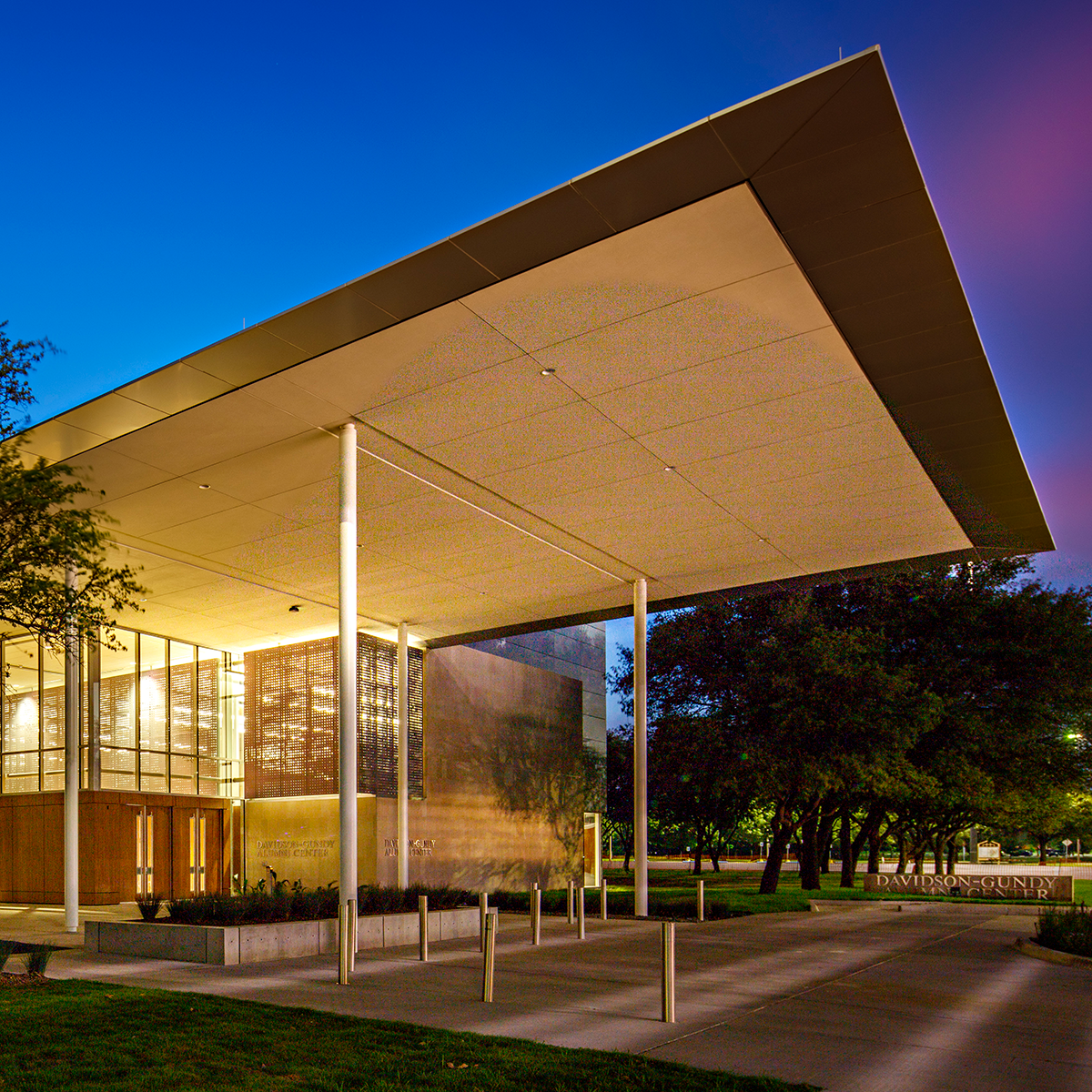
Engineering and Computer Science West Building
USGBC® and the related logo are trademarks owned by the US Green Building Council and are used with permission. usgbc.org
- Certified LEED [Leadership in Energy and Environmental Design] Gold
- Project Completed: August 2018
- Total Cost: $86,130,000
- Size: 206,570 gsf [gross square feet]
The Engineering and Computer Science West (ECSW) building, a four-story structure, is the new home of the Department of Mechanical Engineering. The glass-windowed building was created for research and teaching labs in energy, robotics, nanotechnology and biotechnology. It also features faculty offices, student workspaces, and a 300-seat auditorium. The exterior features light pollution reduction that can block the view of the night sky and a reflective rood to reduce the heat island effect on the building. It combines passive design strategies, high-performance assemblies and calibrated shading elements to reduce overall solar heat gain while maximizing daylight. The interior LEED [Leadership in Energy and Environmental Design] elements include healthy and recycled material, better indoor air quality, 35% less water usage, and a 16% energy reduction.

Take a tour of all the innovative features in the ECSW [Engineering and Computer Science West] building. Can’t play the video? Download it in MPEG-4 (MP4 [Moving Picture Experts Group MPEG-4 Video] ), Ogg Theora (OGV [Ogg Theora Video] ), or WebM (WEBM [WebM Video] ) format.
Sciences Building
USGBC® and the related logo are trademarks owned by the US Green Building Council and are used with permission. usgbc.org
- Certified LEED [Leadership in Energy and Environmental Design] Gold
- Project Completed: April 2020
- Total Project Cost: $101,000,000
- Size: 187,237 gsf [gross square feet]
The Sciences Building (SCI) was designed to be green from its very construction, which was an important factor in the facility’s LEED [Leadership in Energy and Environmental Design] certification. Over 70% of the waste generated from the demolition of the old “Art Barn” on this site, and construction itself, was recycled to prevent it from ending up in a landfill. Over 40% of construction materials came from within 500 miles of UTD, greatly reducing the pollution generated from their transportation. Over 20% of the the building’s materials are recycled.
SCI’s roof and 90% of the surrounding hardscape reflect back sunlight to help mitigate the “heat island” effect common to many urban areas. The building was designed to reduce the energy required for lighting and cooling, and the surrounding landscape and irrigation system was arranged to cut water usage by over 50%.


